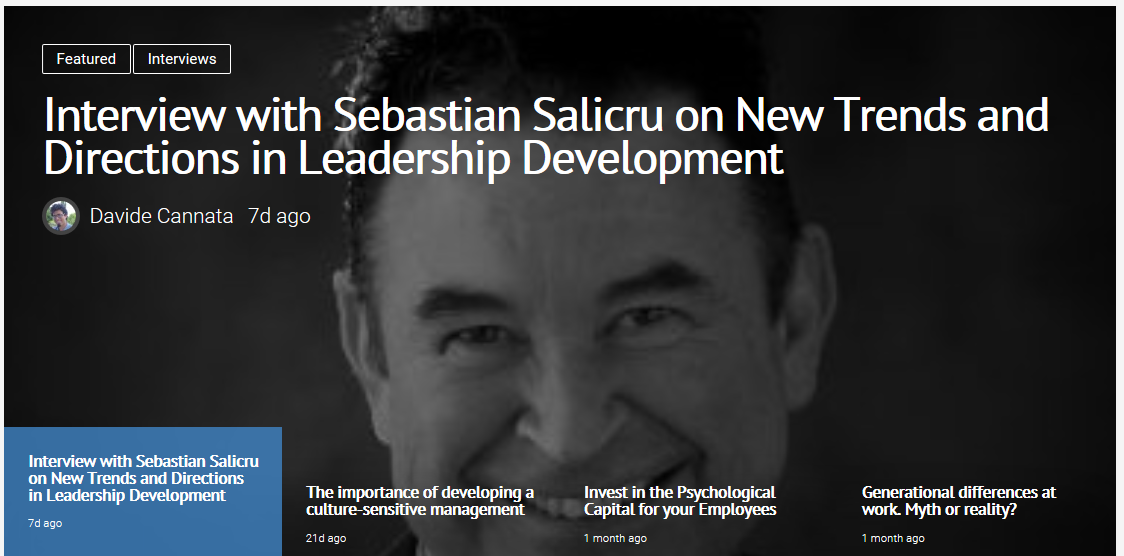
ScienceForWork: Moving HR Management from opinion-based arguments to evidence-based discussions
Interview excerpt
____________________________________________________________________
What are some of the major challenges faced by the leadership industry today?
At the highest level, the single most critical challenge faced by the leadership industry today is that we have been unable to build the leadership capacity we need to move successfully into the future. Clearly:
- Citizens around the world lack confidence in public and private sector leaders; and
- Organisations are worried they do not have enough good leaders.
Evidence:
- Only 13% of employees worldwide are engaged at work (Gallup-Purdue Index 2015 Report).
- 86% of the 1,500 foremost global experts believe that the world is currently experiencing a leadership crisis (Outlook on the Global Agenda 2015 by World Economic Forum, 2014).
What are the causes and solutions?
The overarching cause of this state of affairs is that current leadership development practices (LDPs) are out of sync with our changed world. Despite the rhetoric of many organisations and OD practitioners, it has proven extremely difficult to shift paradigms.
This is obvious given that the majority of current LDPs are still using obsolete practices. Not surprisingly, they fail to equip leaders in dealing effectively with the challenges we face today and will face in the future. More specifically, let me highlight the five most critical issues.
1. We have been too attached to the ‘competency-based movement’
This trend has dominated the industry during the last decades and has been referred to by leading researchers as “a repeating refrain that continues to offer an illusory promise for developing leaders, yet only reflects a fragment of the complexity that is leadership” (Leadership Competencies: Time to Change the Tune? by Bolden & Golsing, 2006). Recent research published the Center for Creative Leadership (CCL) confirms that competency models are incomplete, simplistic, and inadequate in today’s business environment.
Despite all this evidence, to date most leadership development frameworks still remain competency-based. This, of course, doesn’t mean that competencies are irrelevant or should be ignored completely. In moving forward, however, we need to place greater emphasis on using adaptive and relational models of leadership development.
2. We have been stuck with doing mainly ‘leader’ development only, as opposed to doing ‘leadership’ development
David Day’s work is very relevant to this. The challenge here is to shift from a ‘leadership’ development only focus (the ‘heroic’ or ‘lone ranger’ leadership approach – a legacy of Great Man theories from the turn of the century where the leader is the main protagonist) towards a ‘post-heroic’ perspective of leadership. We need to do this by adopting more ‘shared’, ‘distributive’ or ‘collaborative’ models of leadership that better reflect the needs of our times.
3. Increasingly, today’s organisations are operating in a global context. This requires cross-cultural competence and a global leadership mindset
Global leaders need to influence individuals and groups (who represent diverse cultural/political/institutional systems) to help achieve their corporation’s global ambitions while managing multiplicities, tackling huge challenges, grappling with instability and navigating ambiguity. Hence, they must develop a global mindset (GLM), which includes cultural intelligence or intercultural capability. It’s also important to remember that, as we now live in increasingly multicultural societies, GLMs are also relevant to local leaders operating in their own countries (e.g. to effectively deal with workplace inclusion and diversity—important drivers of innovation). Australia, for example, is one of the most multicultural countries in the world.
4. We have a greater need for creative thinking and innovation
The ability of modern organisations to innovate continuously in relation to products, services or processes is critical to both organisational success and long-term organisational survival. Leadership is a chief predictor of creativity — the precursor of all innovation. Strategically, leaders establish work environments that are conducive to creativity and subsequent innovation. They also set, drive and manage strategic innovation goals. As a result, innovative workplace behaviour (IWB) is paramount in today’s uncertain global economy and leader behaviour is an important predictor of IWB.
5. The fifth and final challenge is the need to conduct more impact evaluations of leadership development programs
Conducting impact evaluations is, without a doubt, the most neglected aspect of LDPs. Yet, it’s one of the most critical. In fact, conducting evaluations is an important component of the LD piece itself.
We know that while 86% of organisations evaluate their leadership development activities at the level of participants’ reactions (satisfaction), only 11% evaluate performance at the organisational level and only 3% assess the ROI (return on investment) or ROE (return on expectations). This is a major gap across industries and sectors around the world.
Best practice organisations are committed to evaluating the effectiveness of their LDPs because they recognise that conducting evaluations is imperative to measure expected outcomes and results. One of the main benefits of doing so is that it enables both manager and employee to pay more attention to processes (by using leading indicators) and collective performance outcomes and results (by using lagging indicators). Hence, increasing the practice of conducting impact evaluations will assist organisations to determine how well are they are developing their leaders and by progressively improving their practices will raise the bar to the next level.
What’s your message for decision makers in organisations?
My main message for decision makers (meaning those individuals who procure leadership development solutions) is this. Be critical consumers of the solutions you purchase from your providers. By this, I mean you should always question what approaches will be used and why. Ensure they incorporate best practices and the latest research findings and partner with your providers to ensure that you (the stakeholders and the organisation you represent) receive what you expected.
Finally, ensure you receive value for money (VfM), return on investment (ROI) or return on expectations (ROE), whichever is your preferred approach. Be proactive about conducting impact evaluations and writing case studies. The best way to do this, of course, is by engaging the services of an independent and qualified researcher/consultant.
ScienceForWork promotes the use of evidence-based practices in HR management and people-related decisions. We do so by writing articles that sum up useful and reliable scientific findings in less than 1000 words, and by interviewing practitioners that are making HR more evidence-based.
You can access a full version of the interview here
======================================================
Sebastian Salicru (Business Psychologist) | Leadership Development Expert | Executive Coach |
Facilitator | Researcher and Author | sss@pts.net.au | www.pts.net.au


